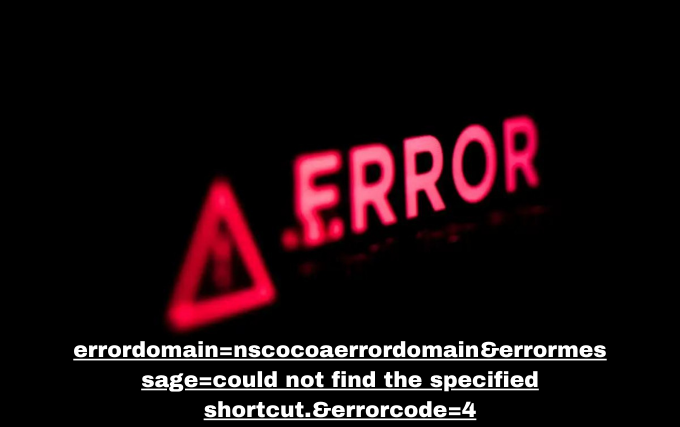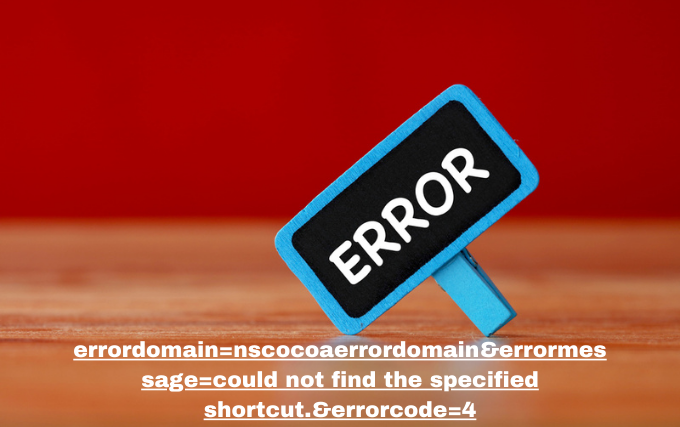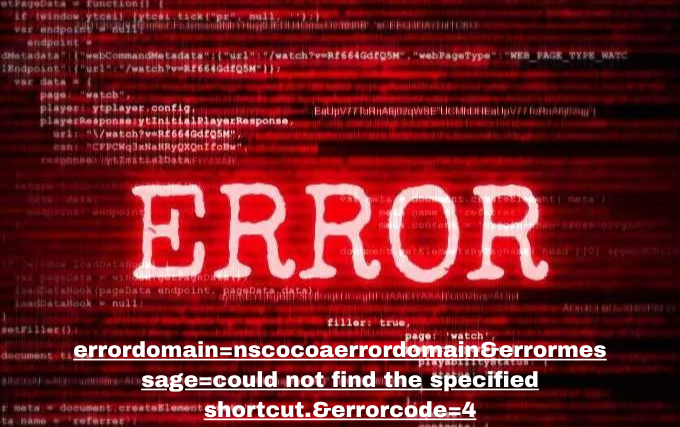Errordomain=nscocoaerrordomain&errormessage=could not find the specified shortcut.&errorcode=4
When using your macOS device, have you ever seen the notice “errordomain=nscocoaerrordomain&errormessage=could not find the specified shortcut.&errorcode=4”? If so, you might start scratching your head in bewilderment and frustration. Remain calm. You’re not by yourself. This blog post aims to inform you about the NSCocoaErrorDomain, clarify the meaning of this error message, and provide instructions on how to fix and avoid running into this problem again.
Understanding the NSCocoaErrorDomain
Imagine the NSCocoaErrorDomain as an exclusive virtual filing cabinet for the macOS and iOS operating systems from Apple. There are various drawers in this cabinet, each of which represents a potential mistake type on your system. Every possible issue, from problems with data persistence to text processing to file and network operations snags, has its own drawer in this roomy cabinet.
It appears as though the system is pointing to this cabinet and signaling that something has gone wrong within when you see “errordomain=nscocoaerrordomain&errormessage=could not find the specified shortcut.&errorcode=4” in an error message. Don’t worry, though; it’s not as difficult as it sounds. In the same manner that we would handle an incorrectly filed document or a stuck drawer in a physical cabinet, there are also methods for clearing objects in the NSCocoaErrorDomain.

It is your system’s way of telling you that something went wrong at the system level when you see the “errordomain=nscocoaerrordomain&errormessage=could not find the specified shortcut.&errorcode=4” in an error message. And despite how complicated it may seem, you can solve it with ease. Step by step, we are here to help you navigate it. So grab a seat, and let’s explore the Apple operating systems’ depths to learn more about the NSCocoaErrorDomain!
The Errormessage: ‘Could Not Find the Specified Shortcut’
This error message reads, “Could not find the specified shortcut.” Let’s investigate this maze. This message usually appears when the system searches extensively but is unable to locate a particular shortcut or alias. You may have tried to access it as a user or an application, but you were unsuccessful. A virtual hide-and-seek game begins when someone moves, erases, or completely makes a desired shortcut disappear.
However, remember that the word “shortcut” in this sense doesn’t only refer to physical shortcuts that you can click on with your mouse. Oh oh, a command or action gone awry can also be the cause of this error. In other words, if you ever get this message, it’s essentially your system alerting you to the fact that it is unable to locate the requested item. It resembles Marco Polo in digital form, with the sad omission of the “Polo” portion. After interpreting the problem message, let’s continue to solve the mystery of the dreaded error code 4.
Errorcode=4 – What Does it Mean?
Putting ourselves in the shoes of Sherlock Holmes, let’s figure out what error code 4 is attempting to tell us. Error codes are similar to secret codes in the Apple world; they are each associated with a particular error. Error code 4 indicates that our macOS or iOS system is attempting to communicate with us via code. Furthermore, what does this enigmatic number code mean? That is, in fact, exactly in line with the error message that we already discussed: “Could not find the specified shortcut.” It’s essentially a numerical depiction of a “missing shortcut” circumstance.
When error code 4 appears on your screen, your system is signaling to you to panic. I’ve been told to look for an alias or shortcut, but it’s not there!” This scenario most frequently occurs when you, the user, attempt to open an alias or shortcut that has either been moved covertly to a new location without leaving a forwarding address, or that has been thrown into the digital trash bin.
Thus, don’t freak out the next time you encounter error code 4! You, my friend, have been entrusted with identifying the’missing shortcut’ suspect, and your system is just playing a game of Clue. Think of this as an exciting excursion rather than a difficult technological issue. Now put on your detective cap and let’s unravel this riddle and bring harmony back to your Apple system.

Common Reasons Behind the Error
Isn’t it similar to becoming a detective? Determining the causes of errorcode=4 is an essential first step in our research. Like our favorite television detectives, we must investigate the potential “culprits” that may be the cause of this problem. Imagine yourself in front of a computerized whiteboard, trying to piece together the information to determine what the main reason is.
First thing to look out for is a shortcut that has been moved or removed from your system without warning. Imagine the system as a player in a game of musical chairs, except instead of a chair, it’s left standing when the music ends.
An out-of-date or incompatible software version could be another offender. Yes, even though we adore the nostalgia of the past, it’s unacceptable to be out of touch in the digital age. This issue could be caused by outdated software since it could be attempting to access a shortcut that isn’t available in the context it is in right now.
One more possibility is a corrupt file system. Your file system may occasionally veer off track, much like an inaccurately designed map. A faulty file system may be leading your computer on a haphazard quest to find shortcuts that have vanished from their intended locations.
Another possibility is that an application attempting to use the shortcut is causing a programming error. An application with flawed code can cause chaos on your system, much like a misbehaving child that disobeys rules.
Finally, a simple slip of the finger can occasionally be the cause. This issue may be caused by incorrect file paths. Imagine trying to reach the person you meant to call by dialing a phone number with one digit off.
Hence, that is our list of possible “suspects.” Now that you have this information, you can go a step closer to unraveling the riddle of errordomain=nscocoaerrordomain&errormessage=could not find the specified shortcut.&errorcode=4 and returning your system to normal. Recall that every mistake has a fundamental reason, and figuring that out is half the fight won!
Effective Solutions for Errorcode=4
Okay, let’s get down to business and tackle the practical side of things. I assure you that errorcode=4 is not as frightening as it sounds, even if it may appear like you’ve stumbled into a tech maze. We can go through this tech maze together if we each bring a little perseverance and determination to the mix.
First, let’s address the most frequent offender—the mysterious missing shortcut. You should start a search operation by donning your digital detective hat. Like a lost puppy returning home, we need to locate the missing shortcut and move it back to its original spot. Throughout this process, keep in mind that you might not find the shortcut where you initially search.
We will need to make sure that our system is updated if it turns out that our shortcut has moved to a new location. Yes, the program or command that has been trying to access the shortcut has to have its file path updated. Think of this as the equivalent, in digital terms, of moving and leaving a forwarding address.
However, we will have to restore the shortcut if it has been removed from existence (oh, the horror!). This is analogous to installing a spare chair in case the primary one malfunctions. The system will be able to function properly and find what it’s looking for thanks to the new shortcut.
Lastly, it’s important to remember that occasionally restarting your computer is the fastest way to find a solution. Turning it on and off again can work wonders, despite how cliche it sounds. This small action can be the digital equivalent of a clean slate, giving your system time to adjust and possibly fixing the problem.
Always keep in mind that fixing errorcode=4 is a marathon, not a sprint. You can handle this technological dilemma with these tactics in your toolbox, albeit it could take some perseverance and thorough investigation. Well, let’s dive right in and get going.

Preventing the Error in the Future
That’s right, you’ve conquered errorcode=4 and made it out of the maze. Congratulations, fellow IT wiz! However, wouldn’t it be fantastic if we could prevent this foolish mistake from entering the room without permission in the future? Of course! So, let’s turn our attention to some digital best practices that can help keep this troublemaker at bay.
To begin with, consider your software as a speedboat that requires routine upkeep and updates to guarantee a smooth ride. Maintaining up-to-date software upgrades will help you minimize the likelihood of running across the annoying errorcode=4. So, folks, keep up with those updates!
Let’s discuss those important system shortcuts next. It’s like playing Jenga with the stability of your system when you move or remove these. Err, err, do not move or remove these crucial parts to prevent a crumbling tower. To put it briefly, let’s give our system shortcuts the difference they merit!
Another helpful tip is to use caution when running commands or configuring apps by paying close attention to file paths. This is like giving your delivery driver exact directions; even a small error could result in your pizza—or in this example, your command—being delivered to the incorrect location!
Finally, since prevention is always preferable to treatment, it’s also critical to be ready for unforeseen setbacks. Regular data backups act as a safety net, offering a cushion when things go wrong. So, set aside some time periodically to backup your data; you’ll be glad you did! Keep in mind that these are not just suggestions, but rather a recipe for a hassle-free digital life. Now go forth, put these practices into practice, and wave goodbye to errorcode=4!
FAQs
Q: What does the error message “errordomain=nscocoaerrordomain&errormessage=could not find the specified shortcut.&errorcode=4” mean in the context of NSCocoaErrorDomain?
A: This error message indicates that there was an issue related to the specified shortcut within the NSCocoaErrorDomain. Understanding the specific details of this error is crucial for troubleshooting and resolving the issue.
Q: How can I troubleshoot the “could not find the specified shortcut” error in NSCocoaErrorDomain with error code 4?
A: If you encounter this error, start by checking the specified shortcut to ensure it exists and is correctly configured. Verify that the code responsible for handling the shortcut is accurate and that there are no issues with the NSCocoaErrorDomain’s error code 4.
Q: Are there common scenarios or causes for the NSCocoaErrorDomain error with message “could not find the specified shortcut” and error code 4?
A: Understanding common scenarios leading to this error can help anticipate and prevent issues. Check for factors such as changes in system configurations, updates, or modifications to the application that may have impacted shortcut handling.
Q: What steps should I take to resolve the NSCocoaErrorDomain error with error code 4 and the message “could not find the specified shortcut”?
A: Follow a systematic approach to resolve this error by reviewing and debugging the code responsible for handling the shortcut. Ensure that the specified shortcut is correctly defined and associated with the intended functionality in your application.
Q: Is there any documentation available for NSCocoaErrorDomain error code 4 and the associated message “could not find the specified shortcut”?
A: Refer to the official documentation for NSCocoaErrorDomain to gain insights into error code 4 and the corresponding error message. Documentation often provides valuable information, including potential causes and recommended solutions for resolving the specified error.
Conclusion
And there you have it, people! It is not as scary to face the terrifying errorcode=4 linked to the NSCocoaErrorDomain as it formerly was. Yes, initially it may appear to be a complex digital web, but keep in mind that there is always a solution, particularly in the field of technology. Through the process of demystifying the error domain, decoding the error message, and uncovering its common causes, we have gained the knowledge necessary to confidently and easily address such errors.
The most important thing to keep in mind is that these technological glitches do not control you. With the correct resources and knowledge, you can solve the errordomain=nscocoaerrordomain&errormessage=could not find the specified shortcut.&errorcode=4, navigate any tech maze, and do your digital tasks without any problems. After all, a seamless digital journey is a process rather than a final destination. Cheers to an unrestricted digital journey and the end of IT troubles!
